Duplicating the CNJ Bronx Terminal in HO scale
Building the Bronx.
Finally.
Four years ago I sold a locomotive I no longer wanted, and with the extra cash I decided to buy something I normally wouldn’t. I went down to the local hobby shop and bought a book that caught my eye, “Where the Rails Meet the Sea”. Mainly due to a picture of a very interesting freight terminal that was once in New York.
The more I studied it the more intrigued I became with it (ok, maybe obsessed). The complex trackwork was hard to believe! An entire rail yard, freight house, car ferry and engine house in about 1 acre.
I had to build it. Fortunately for me online there was a pretty good track diagram of it, but little else. I studied the track plan for quite some time and decided to re-draw it accurately in CAD.
Building the trackwork would be an extremely difficult task. Possible, but likely well beyond my skills. For a while I had been tossing around the idea of making a fixture to assemble turnouts at the workbench, and thought this approach might work well for something like this.
I spent a bit of time contemplating how to make a fixture and worked out some of the details to manufacture a prototype. I did a few test tries on some scrap wood.
The initial tests worked quite well, and I built a few #6 turnouts with it. I was quite impressed myself, and decided to use the fixture to build turnouts for my Port Kelsey which I was just getting started on. Well to make a long story short, a few people spotted the fixtures and wanted one for themselves. Ron, my brother also saw an opportunity with them and offered to bring them to market online. And Fast Tracks was born.
Four years has gone by and still no Bronx Terminal. Until now.
I don’t have much in the way of an overall image of the terminal. I do have one, but it is packed in a box somewhere as I still haven’t unpacked all my model railroad stuff after our latest move. Once I locate it I will post it on the site. For now, you will have to refer to the track plan. Tonight I completed the first piece of the Bronx puzzle, the triple lapped turnouts at the engine house end of the facility. This is on the lower left hand side of the drawing. The three lapped turnouts are the most complex portion of the trackwork, and I should have started with something simpler, but I was looking for a challenge.
Update – Image found
Below is a 3D model I made of the portion of track I started with…
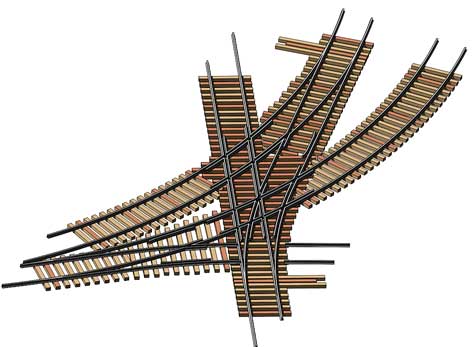
Image Copyright (c) 2007 Tim Warris
and the completed trackwork…
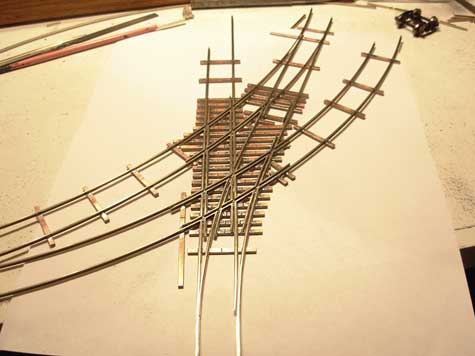
Image Copyright (c) 2007 Tim Warris
Here is a shot of the real thing.
If you look closely at the image above two rails can be seen protruding from the right side of the lower turnout. These rails led into the engine house and never actually crossed through the turnout, they crossed over it. To get to the engine house the crew had to lay steel rail across the top of the turnout, and drive over it! I am not making this up, they actually did this for decades. If you look close, a support can be seen in the middle of the turnout for the rails. The portable rails can be seen on the lower right side of the image.
If you look closely at the lower left front of the engine in the large version of this picture below (click on the picture) the engine is sitting on these pieces of rail on top of the turnout.
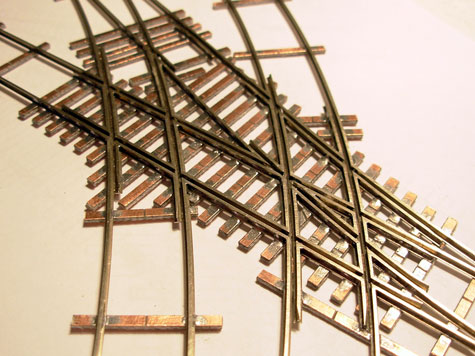
Image Copyright (c) 2007 Tim Warris
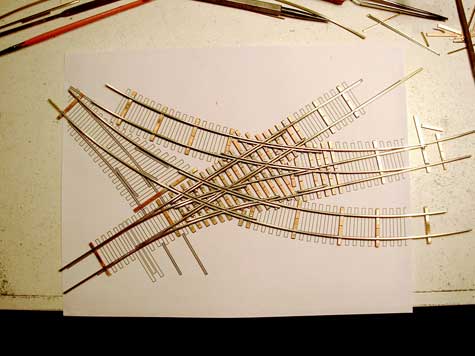
Image Copyright (c) 2007 Tim Warris
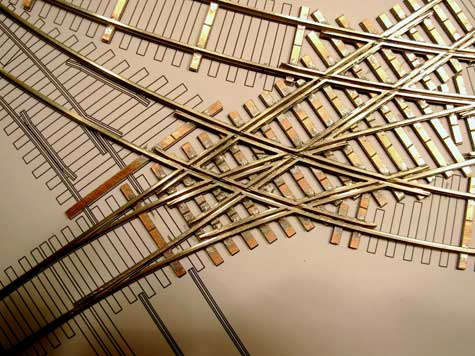
Image Copyright (c) 2007 Tim Warris
Here is a short video showing a set of wheels rolling through the complex trackwork. It operates extremely smooth, I am very excited with how it turned out and am looking forward to the next piece of the Bronx puzzle. Click on the right facing black arrow to start the video.
On to Next Section
Update – Nov. 25, 2008
Construction Posts Index
Since there are lots of posts on this blog that are not necessarily related to the building of the CNJ Bronx Terminal, relevant posts about just construction can be tricky to follow.
To help make it easier to follow along with the building of the layout, I have added a “Next Section” link to the end of each post that deals with the build. Simply click on that link to move onto the next post. You can follow these all the way to the most recent relevant post.
I have broken down the posts into the following categories, in order from the beginning to the most recent:
- Track Construction
- Benchwork Construction
- Fake Rust Fascia
- Rebuilding a Brass Boxcab
- Building a Walther’s Carfloat
- Designing the round freighthouse
About the Author:
I'm your host, Tim Warris, a product developer in Port Dover, Ontario. Since March of 2007 I have been documenting the construction of the former CNJ Bronx Terminal in HO scale. For my day job, I design track building tools for Fast Tracks, a small company I own and operate. Fast Tracks makes it fast and easy to hand lay your own trackwork. Stop by our website to learn more!
Posted by: Tim | 03-10-2007 | 02:03 PM
Posted in: Latest Posts | Track Construction
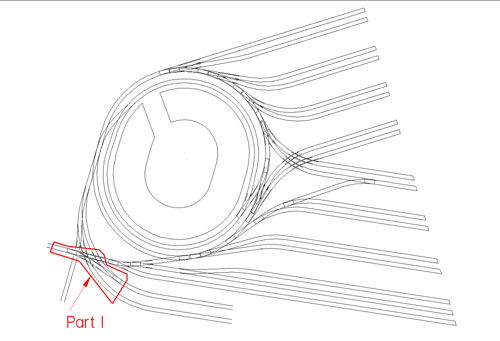
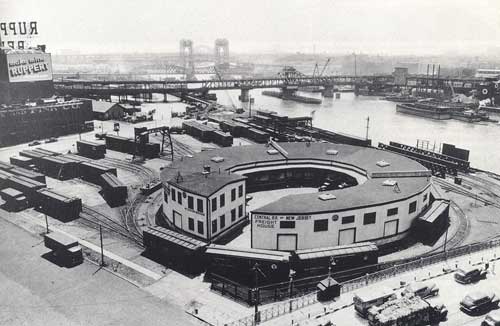
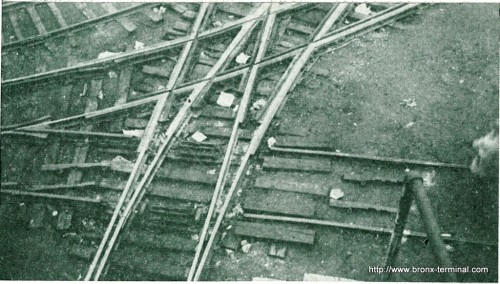
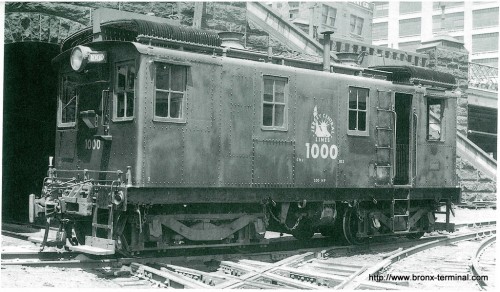
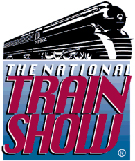
Great stuff — thanks for the Jigs — I’m definitely
going to try this soon —
ID
Great work
And I’m scared of laying a plain old #6….
Impressive. Very impressive.
very, very afraid…
looking forward to more pictures of the new layout…
Hi Tim, outstanding work. I almost know what you went through, I had to build partial turnouts on my model of the SS Badger. The bracing for removable tracks you refer to, could they be turnout actuators arms instead?
Dan
Hi Tim,
Wow! Great work. Your Fast Track jigs are the greatest. Thanks
Dick Martel
Florida 82 degrees Keys
Brad,
Don’t be.
Tim
Wow Tim,
So, when will the fixture for that come out in N scale, C55 rail? 😀
Looks great, stunning actually. Its amazing where one inspiring book can lead a person, eh? And finally back to the terminal. Wunderbar. I’ll be following your progress, hoping to learn a lot in the process.
Grace and peace, BD
Tim, you’re mad! MAD I tells ya!
That’s some incredible trackwork you’re doing. Simply amazing. And the subject is incredibly cool.
One thing I’m not sure I’m clear on from the map – was this completely self-contained? The only connection these tracks had to the outside world was by car ferry?
Looking forward to seeing your progress!
hi,
thats a very good work,its great!!!
best regards from germany,peter
Hi Tim! Finally I found my way into your site. Wow! It´s impressing! Myself I will stay happily put with turnouts that can be done with your more normal fixtures. They made me sooo lazy. But still I wish I could……… and realize I will continue doing just that! It takes me ages to custombuild just about anything. Well you´re a living proof that the most impossible things can be done… by some… guys.
Hi Tim!
The way of letting track climb on top of other tracks as is on your to say the least complicated track was quite common on seldom used connections here in Sweden. In a direct translation to english it´s called what it is in swedish, -climbing turnout. The most common use of this turnouts was to connect hidden engine depots out where mainlines passed through deep forests. This system as far as I know was to keep the depots hidden from spy satellites. Permanent tracks with roadbeds would be harder to camoflague from the enemy spy aircraft ( read USSR ) in the cold war era.
Hundreds of steam engines where “conserved” for eventual electrical power sabotage in the case of war around the country. All mainlines in Sweden are electrified since the 40-ties.
Wood and water is the only easy to get, local power source if we were to become under “siege” .so the idea was to keep all standard steam engines in running condition hidden in war depots out on the countryside. This system was abandoned as late as the early 90-ties. Anyway this piece of “portable” trackwork is a really interesting piece. I have drawings and some photos of this if you would find it interesting to look at. I just have to locate them as the unpacking is in process after our last move.
Best regards
Mats Lindholm
Great job Tim! Very inspirational. I look forward to following your progress.
Lance
Please contact me about a potential article for Model Railroad Planning Magazine (Kalmbach annual) as a follow-up on Charlie Conway’s article on the Lackawanna’s Harlem Terminal RR in the 2007 issue.
Tony Koester
editor
Hi Tim! I just have to look in to your site now and then to get inspiration. I am seriously jelous of your skill. Joking! I am very happy with the fixtures you made for me, even single wheelpairs run smoothly through, amazing! And it looks so good! I hated turnout construction before the Fast track era. Thank you for the advice on the filing jigs for the dual crossing. You were right, looooots of tiny pieces to produce in the right angle. Without your tools I would probably been better off spending my money on a shrink.
Best regards!
Mats
Congratulations on a superb piece of modelmaking. considering the standard you have achieved I am a little surprised you were so nervous about tackling it………….it would suggest you are an experienced modeller.
I find it stimulating and encouraging to see work like this, rolling up your sleeves and tackling something so different and new is both brave and energising. please follow up Tony Koesters invitation to write it up for publication the wider modelling world needs to see work like this and to learn how such results can be achieved.
Carry on the good work…………your site is now on my Favourites list.
Bob
LOVE your blog, thanks for entertaining me
Hope there will be more posts soon
regards, terry
ps – sorry im not that good in writing in english because I came from europe – but i understand a lot
That’s just astonishing workmanship!
Amazing piece of trackwork, astounding workmanship, very very impressive. I have enjoyed your site for a few years, keep up the fantastic work.
Karl.A
Hi:
Really enjoyed reading this. I have a slight preference for this over the Harlem Transfer Terminal which is similar.
My favorite characteristic is the design of the freight loading doors of the freight house allwoing a string of cars to be pulled up to them spaced for the right interval!
I’ve actually been on the ground where this was as also I have been to the Harlem Transfer property.
They are both delights of ingenuity. I look forward to your updates.
Best of luck,
Gareth
The trackwork looks like Excedrin headache number 100 to me but looks great I will follow along with great interest. Keep up the good work
Hello Tim your skills never stop amazing me.I hope you are enjoying your new place of residence,I will miss you guys on this years Double headers tour. keep up the great work Tim ! Greg
What a project, but it looks like you’re up to the challenge. I’d like to see the gapping and wiring for that beast. I’m glad to see someone modeling the old industrial areas. I’ve given strong consideration to modeling the Wilmington, DE waterfront along the Christiana River. There were several ship builders, a RR wheel foundary, a couple of RR car builders, and a small steel mill along with a good assortment of frieght transfer warehouses, some livestock pens and other stuff. It was served by the PRR, B&O, and the Reading. The trackwork was almost as nuts as yours.
I just poked around at some of your photos. You are such a good modeler you should really consider getting Helicon Focus software. Check out their web site and you will be amazed at what it can do. There was an article about using it for model photography in the Keystone Modeler a few month ago.
Hi Tim,
Absolutely wonderful workmenship. For what it is worth I grew up in the south Bronx in the 1950s and played in this yard as a kid. The engine house was under the bridge going over the Harlem river. the doors on the freight house were spaced for 36′ box cars and it was interesting the moves made to unload 40′ cars.
Keep up the great work and I will keep watching.
Take care, Peter
The fire departments in the age of urban streetcar systems
had hose ramps. These were metal pieces of light duty girder assembled in ‘V’ ramp which allowed them to lay hoses
and not cutoff trolley service(or have hoses cut). Near
docksides, for one example, permanent steel pipe or
masonry troughs/conduits were constructed to serve the same
purpose if the dockfront roads had trolley or rail
service. Of course big warehouse/dock conflagrations
would have cut off trolley car service because it would
have been too hazardous to operate it even if the fire
did not take out the overhead. Europeans apparently
did not have these architectural or portable track
ramps, because when I brought the subject up on a
tram site Dutch, German and British fans/modellers
said they were nonextant there.
Regardless, that is nice work you are doing,
and if you feel like building another similar yard,
the adjacent (on the other side of the Willis Avenue
Bridge) DL&W yard has its plans in John Droege’s
FREIGHT TERMINAL & TRAINS, as I mentioned on the
CNJ YAHOO group.
The Lackawanna’s ovoid freight house was open on
both sides rendering two closely spaced ‘C’ shaped
structures when viewed from above.
As a small boy I remember the New Haven working
express cars in the street just east of the CNJ’s
terminal. They intruded into the street which formed
the east side boundary of the CNJ in the process.
This would have been a Sunday morning, because I
was with my father who would take me for walks
in the industrialized and quiet South Bronx on
Sunday.
I know that they just about connected to the CNJ
because I remember going between the ends of
the express cars on the irregular belgian
blocks of the street, and the box cars at the
CNJ bumper. My father had to make sure none of
the trucks being used to unload the express were
backing up , so we could get by. The space
between the railcars involved in this discussion
would not have allowed a truck through on that
day.
Except for the fact I have read that the CNJ
was isolated, I would have thought that the
New Haven had at least one track which crossed
the street into the CNJ yard to make a connection.
Good-Luck with your modelling. and your
enterprise.
Peter Boylan
Hi Tim,
Saw your Boxcab model and have a source for power trucks to fit it. Go to http://WWW.hollywoodfoundary.com. They are an Australian outfit who sell motors and power trucks for all gauges. There is a 7′ wheelbase 36″ wheel option that should fit your Boxcab.
Cheers,
Steve Puchalski
Hamilton, Ontario
whats the late news on your plan for a laser cut car float?????
Joel Norman
Harvester Mo.
Amazing !! Only a perfectionist can come up with what you have come up with. A conqueror spirit. Well done ! Am contacting your service section to get advice on the best combination of your products to buy to construct my new layout. Regards from Australia.
scale model trucks
Do you have a newsletter to sign up to?
[…] a book largely about car ferry operations – rolling boxcars, etc., on and off ferries and barges. Tim is modelling the CNJ Bronx Terminal – a yard in about an acre with no connection to other trackage except via […]
I have been going over this Bronx Terminal site you are recreating and it is very impressive. I can see why you dove head first into the challenge of it. Starting at the hardest part is not unlike anybody that is obsessed with a project. I know because I live from one obsession to another. My latest is a 44 foot long On3 module project in 9 sections with all track being hand laid with your fast track products. Having never worked in On3 before or never laying hand made track is only a few of the required things I need to learn to pull this off. Your latest on-line newsletter helped to ease my pain and you must of increased the audio on the videos because I can hear them now without earphones. I am excited to start building track and turnouts now that the modules bases are ready and you have made me feel that once I get started I will find that this monster track can be tamed and become a pet project. Thank you for sharing your methods and designs with us all.
wow: that all most like streetcar trackage. Have you though about a jig to make point and mate(single point) turn outs. As for the steel laid on top of the rails, they do that still in Austraila, were small railways cross the main lines. I will forward some pics. Patrick
Well… I proabably committing all of the sins… I don’t have a website… I’ve only been model railroading for 3 years… and I do O Scale. However your weathering techniques are incredible. I am painting an undecorated woodside reefer. When I’m done I will be putting some custom decals on it that I designed. Then… I’m going to follow your great steps for weatherizing.
Matt
CEO
Brisbane & Bushong Railroad
As a teenager a half century ago, I recall seeing CNJ’s Bronx Terminal. I recently came across the following photo of the CNJ #1000 boxcab which I have never seen before, have you?
http://www.ouroldneighborhood.com/Images2/switchingcarsatBronx.jpg
Hi Larry,
Thanks for the link to the image. I did have that image, although not as good quality as the one in the link you sent. I don’t recall where I got it from either. Thanks for sending it, its a good addition to the collection.
Tim
Great model trackwork! Where can I see latest pix?
kl anderson
Great work, great site! I would like to send you some CNJ stuff I have, but wasn’t able to locate an e-mail address…HELP!
Also, you may want to check out the “CNJ In Mauch Chunk” website about three Liverpool (as in the Beatles) modelers who, like you, aim to duplicate a small stretch of the CNJ (in this case, as of 1930)
http://www.homauchchunk.co.uk
Robert – I can be contacted at tim@warris.com
I am no expert. Just a model railroader since the ’40s. In yard tracks or in old industrial tracks, I believe that little or no ballast was used. No high speed traffic to worry about. In the East, if ballast was used it was most often ashes from locomotive fireboxes. Over the years the little ballast that was used would sink into the dirt and the color of the ground in and around the tracks would be the color of the dirt that came up through the ballast.
Where ever there was heavy foot traffic to load or unload freight cars dirt would be brought to level the surface between the ties so that the workers would not trip while working. After decades the ground would look similar through out the yards except at turnouts where track maintenance was needed and in areas with little foot traffic. In the areas where the ties could be seen, the ballast was coal ashes. Locomotives of the day created a lot of coal ash and they had to do something with it.
I have no way to confirm this. It is only my observation of years of looking at pictures of track and its environment.
Hello, my name is Tasha Andrews, I am the executive assistant to Bishop Ronald Bailey of Love Gospel Assembly in the Bronx. He had bestowed upon me the task of locating a model tugboat for use as a prop this Sunday 1/31/16 for his preaching. I came across your site and wondered if you have anything like that that could be borrowed, used then returned. As today is Thursday, there is very little time to order one online let alone build it,
If this is something you could help us out on, please feel free to contact me at 917-662-3632. I would so greatly appreciate it. Or if you know where we could get one, that information would also be greatly appreciated. Thank you in advance and be well.
[…] zu sabbern, der sei verwiesen auf den (englishsprachigen) Blog von Tim Warris: bronx-terminal.com. Hier ist der erste Baupost, aus dem auch beide Bilder […]